Flagstone Joint Options
Compare flagstone paving with gravel, planted & mortared joints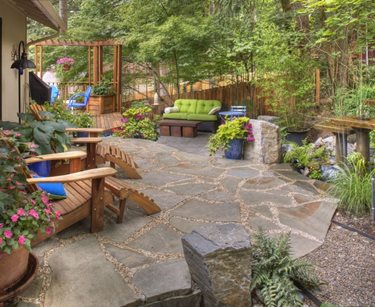
Flagstone with Gravel Joints
Flagstone on sand with gravel joints solves drainage problems in tight spots between structural impediments.
Simple inch thick flagstones derived from locally quarried stone are the ideal problem solvers for a narrow site wedged between a retaining wall and the house. Here water shed from the driveway above can create drainage problems without permeable paving. Flagstone is one of the best for patios due to narrow pebble packed joints that allow every opportunity for water the percolate downward instead of running off. Pebbles help to integrate the flags into the gravel walkways using the same diameter materials. On the far side where the slope continues to drop away from the house, a wood deck provides yet another problem solver without restricting drainage.
Pro Tip
On coastal projects, DC West Construction of Carlsbad, CA must build to stringent building codes that strictly prevent any site drainage into storm drains. The result is beautiful stonework that hides a complicated infrasturcture of drainage and irrigation underneath paved surfaces. Flagstone with open joints for drainage may require at least a foot of excavation before laying the sub-base for a project. "We typically dig it out, then arrange drain line, which is topped with a layer of coarse gravel, another layer of fine gravel, then natural soil and irrigation before the flagstones are laid on top," says company owner Micah Helkenberg. This demonstrates how a seemingly simple flagstone patio can in fact be a complex "sandwich" of layers to achieve permeability and drainage.
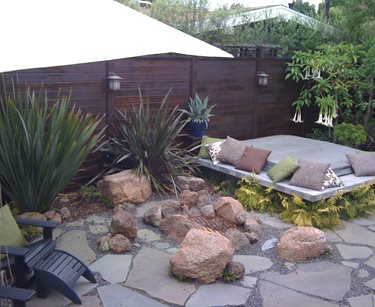
Fine gravel in the joints of flagstone can travel to become a safety and maintenance problem in heavily used spaces.
When flagstones are laid on a sand leveling bed or even directly onto the soil, the joints must be filled to make it safe to walk on. Fine rounded gravel is the most commonly chosen filler because it allows water to penetrate into the soil below, thus reducing unwanted runoff. Look closely to see how the small pebbles have traveled beyond their designated slots to sit on the flags. Step on a flag with a few scattered pebbles and they'll roll, which can become a safety issue. In fact, this traveling gravel will plague many modern gardens where gravel is used adjacent to paving or in lieu of mortar.
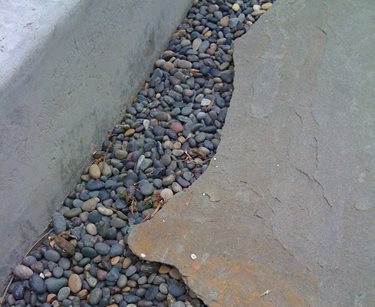
Dark gravel shows every piece of organic matter which accumulates wherever there is a nearby tree or lawn.
This close up shows of the kind of gravel used to fill spaces in between flagstones. Before you select this option, be aware that dark gravel reveals every bit of organic matter that lands there. The bits and pieces stand out against the pebbles in sharp contrast to interfere with the desired color. In a short time it loses its solid black color. Sure, you can remove this detritus, with a blower, but that only drives the bits and pieces into the next mortar joint. Reserve this gravel for very narrow joints that won't have space to build up litter.
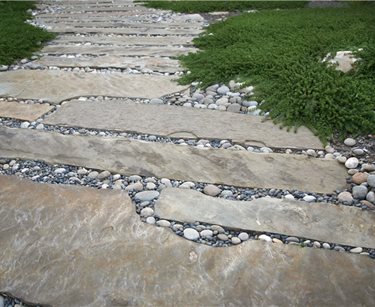
Think outside the box by using two materials in the joints of a walkway.
The wide joints between these long, narrow pieces of stone are filled with black gravel and white pebbles. The pebbles add another texture and make windblown debris less visible in the black pebbles. The interesting shape of the flags and the unique combination of jointing materials gives this walkway a very organic feel.
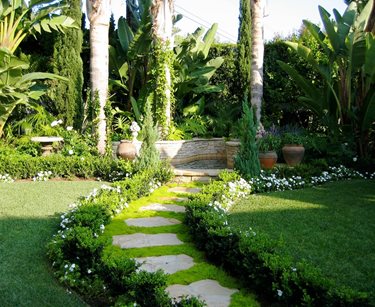
Flagstone with Planted Joints
Leave sufficient space between stones for plants to establish themselves.
Plants can be used to soften a flagstone patio or walkway. Certain groundcovers and grasses are well suited for growing in the small opening between stones. In this example, pockets for larger plants and gaps between slabs are wide enough to establish ground hugging mats that fill in quickly. For a lovely fragrance use something aromatic like creeping thyme.
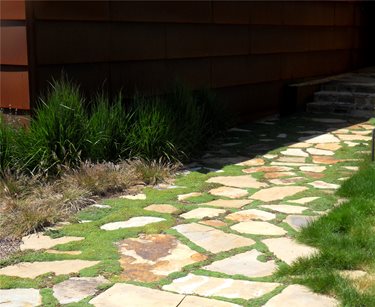
Strategize the right underground irrigation system to keep plants in the gaps thoroughly moist through the summer when stone heats up.
This pale flagstone set on a sand bed pops with an all green mat-like groundcover to fill the gaps and outline the edges. Planted joints are far more successful in cool climates where the flagstone doesn't absorb so much heat in the summer. This is hard sandstone from Arizona that resists heat absorption far better than slate or quartzite. The biggest problem with planted joints is getting enough water to the roots of the plants to keep them green and vigorous. Contemporary designers should be well versed in the newer underground irrigation systems which are essential to keeping plants alive in such small slots of ground. This form of irrigation eliminates the problem of surface water unable to penetrate densely planted joints.
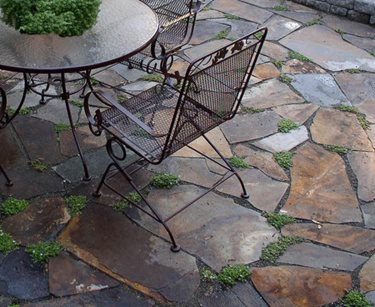
Avoid furniture with feet that are incompatible with the joint size and planting in an on-grade flagstone patio.
Note the disk-shaped feet on this chair. They're small enough to get caught in these gravel filled gaps between the flagstones. They also make a perfect hoe to scratch through these tufts of groundcover. This illustrates one of the primary problems with flagstones without solid mortar. Imagine trying to scoot the chair closer to the table without catching an edge or wiping out plants. In wet weather so much weight pressing down in just a single square inch can also cause it to sink. This lovely flagstone patio would be better suited to large leg wood furniture. But if that is not possible, the planted spots should be kept well away from where the table and chairs are located to protect them from damage by heavy use and furniture.
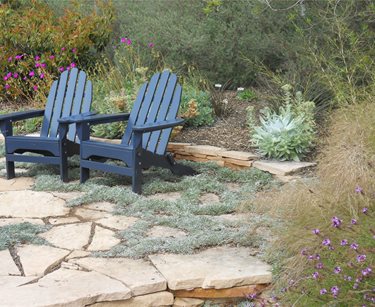
A pastel hued flagstone calls for soft colored plants in the joints for a more visually relaxing effect.
For a home with stack stone veneer on the facade, try to recreate the same look in the landscape with flagstone. Here the lightweight Arizona flagstone is used to create a small curb, then is repeated again in the foreground step riser. This is a rare light colored flagstone that looks sharp when just the right colored plant is used to fill the joints. Here a blue-gray groundcover is a cool accent against the buff tone flags for a lovely pastel effect overall. Note where foot traffic is most frequent, the plants have been trampled out of existence illustrating the problems caused by planting joints in heavily used parts of the landscape.

Bridge an expanse of lawn with flagstone steppers.
Flagstone is the perfect material for bridging a large expanse of lawn. Flagstones are often added to turf to help reduce soil compaction where foot traffic crosses the lawn. The grass will grow right up to the edges of each stone as long as sufficient water is supplied. Ensure that the flags are set at a level that allows for a lawn mower to be pushed or ridden over them.
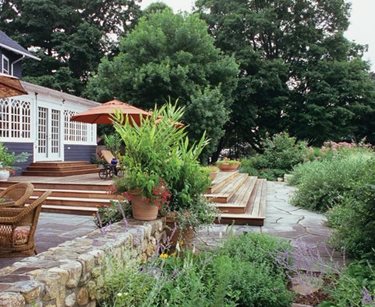
Mortared Flagstone Paving
Mortared joints make for a smooth surface for sliding chairs in and out from a dining table.
On this property, flagstone is used for a dining patio and transition paving that leads into the garden. The upper patio is flagstone-on-slab with mortar joints that make it easy to slide chairs around in this dining area. If this space had been set on sand, as the rest of the stone was, the chair legs would catch on the edges of the stones. Mortared joints make for a much smoother surface.
Pro Tip
“We start by looking at the intended use of the flagstone area. If it is to be used primarily for the main dining and entertaining area, we recommend that the flagstone is mortared directly to the concrete base underneath. This is because we can provide a surface that will accommodate patio furniture and traffic without the uneven surface that plants and gravel cause,” says Roger Haywood of Accent Landscapes in Colorado Springs, CO.
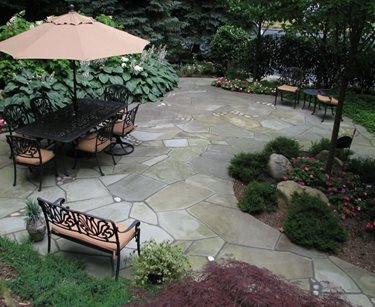
Occasional accents in a mortared flagstone patio provide much needed variation for interest and a unique look.
Cool gray flagstone pops out with darker gray mortar joints that make the shape of each individual slab more visible. Overall this is among the most sedate flagstone patios due to the uniformity of color. To add visual interest, the mason has added white accent stones into the dark mortar making these points pop out of the muted paving. This illustrates how important it is to add accents with contrast so they and the money you spent to set them, contribute to the space as your designer imagined.
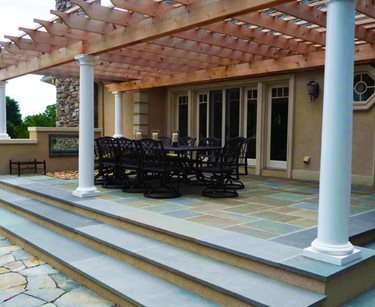
Create a hierarchy of spaces by using mortared flagstone to designate more formal spaces.
Here the upper dining terrace is paved with milled flagstone that has been mortared in place. The bottom patio is irregular stones laid on sand, which has a more casual feel. The mortared joints add a finishing touch to the terrace and have a similar look to grouted tile. For the cleanest look make sure your mason is precise about making all the joints the same size. Uneven joints can look sloppy and destroy the milled flagstone’s formal appeal.
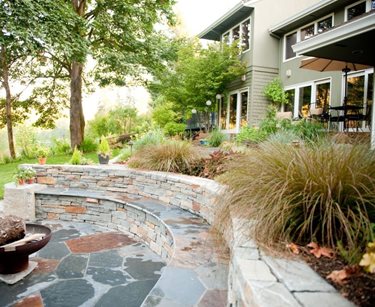
Use mortar to unify a patio with a bold pattern and strong color variations.
This flagstone patio has a bold pattern and strong color variations. The lighter mortar color acts as a unifying element that ties all the stone together. The mortar joints were kept very thin so that they would not distract from the beauty of the stone. The same flagstone was carried over onto the seat wall. When this is done, pay close attention to the size and detail of the mortar joints. Keep them narrow and precise because mortar contains sharp sand that can easily snag fibers of clothing if not carefully finished by hand.
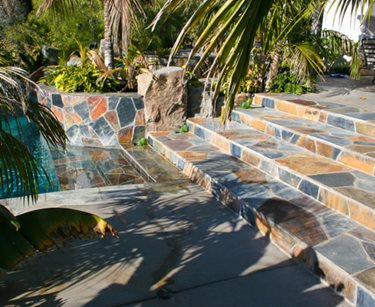
Accent your landscape with mortared flagstone steps.
If cost is prohibiting you from using flagstone for a large expanse of paving, consider using it as an accent material. Here, the stairs have been finished with irregular flagstone with mortared joints. Light mortar provides high contrast against the blue and yellow colors of the stone. This type of application takes the stairs from something ordinary and functional to an eye-catching feature. The flagstone is also carried out into parts of the pool.
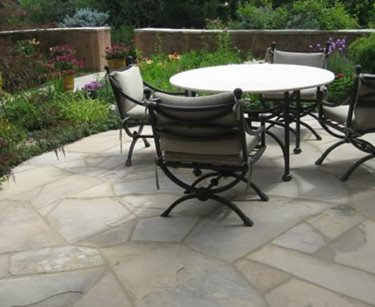
For a very subtle effect select a mortar color that is similar to the stone color.
If you’re looking for a paving material that will blend nicely with its surroundings rather than steal the show, light flagstone with matching mortar is a good option. You’ll get a very subtle look, but still with the custom quality you desire. This approach also works well if you have pieces of stone that are many different shapes and sizes, creating a fragmented network of joints. When the mortar is closely matched the joints will be less noticeable.
Pro Tip
“We always start with a reinforced concrete base that has proper slope for drainage. We then pressure wash every piece of flagstone to provide a clean surface for a good bond. Each piece is fitted and mortared to the concrete with a mixture of cement, sand, and water. We always use a color additive to the mortar for setting the base and for the grout joints between the stones. We encourage sealing the finished project with either a matte or glossy sealer to prevent water and ice from penetrating the grout joints,” says Haywood.

 Backyards
Backyards
 Front Yards
Front Yards


